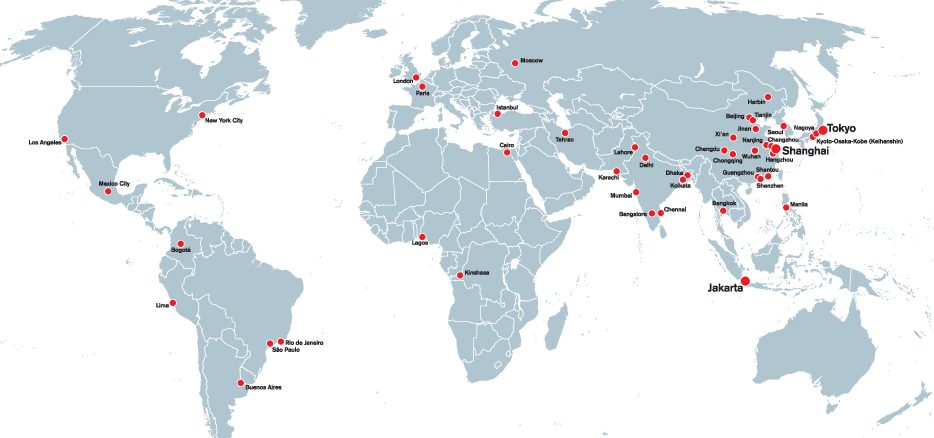
When you produce the intensified agriculture and you reduce the number of people on the land, what happens to those people? …They are chased into the towns. They lose their jobs on the land. If they go into the towns, there are no jobs, there is no infrastructure…. On top of that, you are breaking families, you are uprooting them, you are throwing them into the slums. Do you realize that in Brazil, the favelas (slums) did not exist before the Green Revolution of intensifying agriculture?
~Sir James Goldsmith
Writing about megacities was a natural follow-up to our 2nd Quarter Wrap Up focusing on The Rise of the Asian Consumer. Asia is the epicenter for the rapid urbanization underway.
In 1800, 3% of the global population lived in cities. As of 1950, there was one megacity—New York. Today, an estimated 50% of the global population lives in urban areas, and there are now 47 megacities—30 of them are in Asia.
Everywhere I turn, I see evidence of government policies quietly migrating people into urban areas. It’s not one big thing—and there are no announcements. More often, it is thousands of little things. Funding is cut for roads. Broadband is not available. Every other year, the training requirements for volunteer fire departments in rural counties increase. Home insurance is no longer available. Mortgages are hard to get. Phone service is mysteriously unreliable. Not surprisingly, most real estate values in rural areas go nowhere at best, and many home prices fall.
Look around, and you will also see highly unusual fires happening in rural areas. There are occasional serious power outages and inexplicable torrential rains and flash flooding. France is using climate as an excuse for policies and taxes that make living in rural areas difficult, if not impossible. The result is riots in Paris. It’s a plan, but no one believes the reason given—climate—because it does not make logical sense. Meanwhile, China is building cities that sit empty—what are they stockpiling them for?
The news tonight brings stories of Walmart testing robots. Go back and read the Romantic poets William Wordsworth and William Blake writing about the streets of London during the Industrial Revolution, as people were driven from the land into the cities to create cheap pools of labor for manufacturing—and there were not enough jobs. Ask yourself, what would happen today if there were no manufacturing jobs—if machines could do all the functions, save the most skilled?
I keep asking, “How’s this supposed to work?”
Whatever happens, the world is full of great cities that are magnets for talent and culture. I visited some this year—Sydney, Zurich, Amsterdam, Sofia, and Vienna, to name a few. Nurturing their greatness is essential to our human future.
Real estate companies are growing in number and size to meet the demand for more urban dwellings, real estate, and infrastructure. As fortunes are made in Asia, the wealthy and their money are moving around the world. A great deal of that capital is recycling into global real estate.
With global real estate valued at more than $200 trillion and only a small amount of its ownership reflected as of yet in the global stock market, the ongoing convergence of real estate with the securities markets will continue. Take note—real estate has recently been moved out of banking and into its own industry classification. Consider this an important signal.
With our 3rd Quarter 2018 Wrap Up, we are adding urbanization and its related impact on real estate investment to our list of primary trends to track. Primary trends are both important and long-term. You and I will feel the impact for decades to come.
As the year comes to a close, I look back on our four Wrap Ups published this year. We covered some of the most significant primary trends underway: pension funds, the space-based economy, the rise of the Asian consumer, and, finally, megacities. It’s a lot to digest.
If you work on digesting these trends, however, the daily news will start to make a lot more sense. If you have a map of the whole territory, you can understand the scattered information that flows daily in the wider context of where it fits on your map. It is like having a clothes rack by your door for all your coats and winter jackets. You have a place to put them instead of having them pile up over the chair or on the floor.
The Solari network is first and foremost an intelligence network. You and I are navigating through a period of unprecedented change. The more we can create and share our maps, the smarter we can become, helping each other grow in the midst of a mountain of secrecy and an ocean of disinformation.
No matter which continent you live on—and whether you live in a city, a suburb, or the country—take some time to digest the 3rd Quarter 2018 Wrap Up so that you can add Megacities and the Growth of Global Real Estate Companies to your map!
